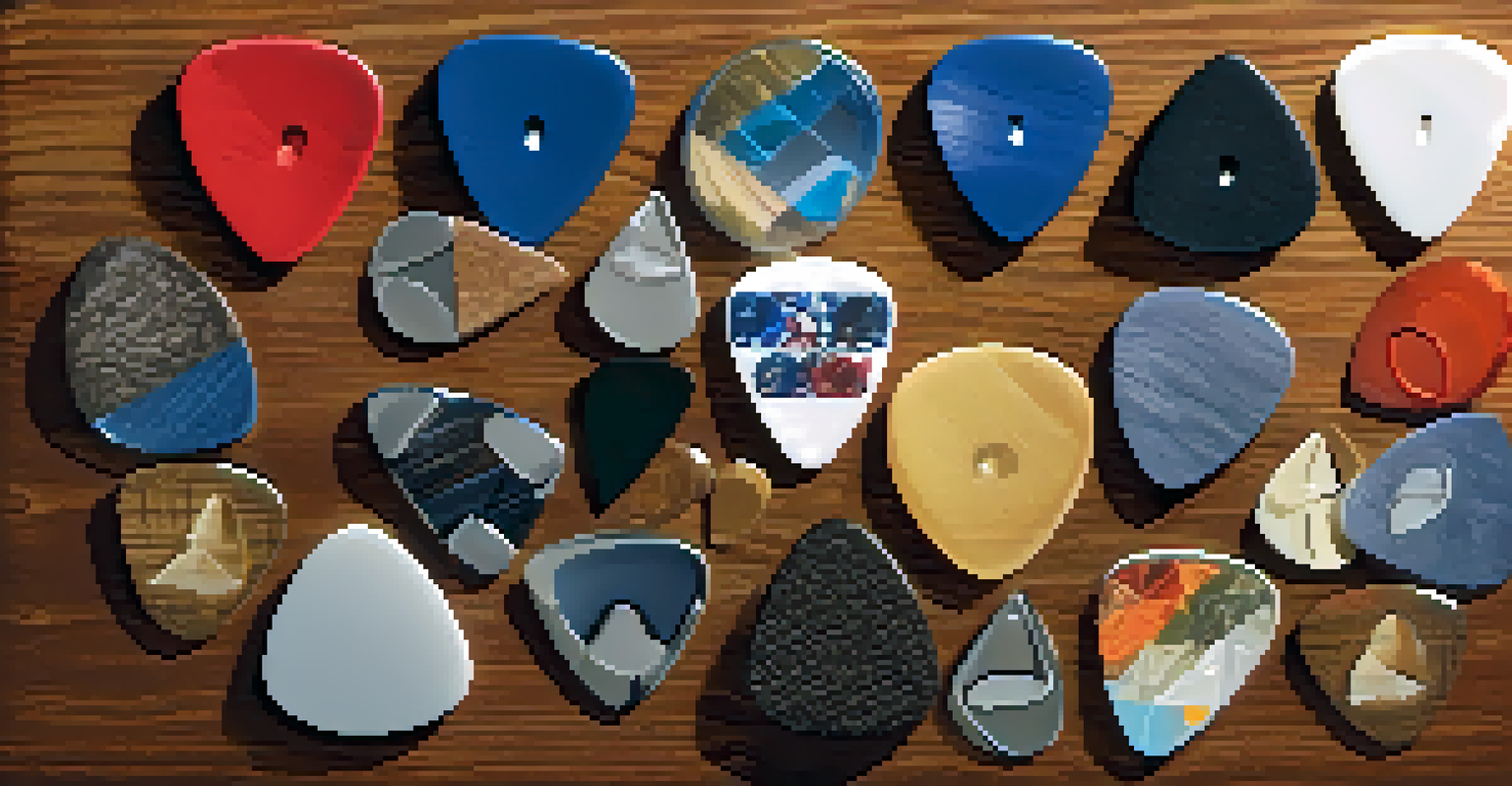Guitar Innovations: Key Technologies that Shaped the Instrument

The Birth of the Electric Guitar: A Game Changer
The electric guitar emerged in the 1930s, transforming the music landscape. By utilizing electromagnetic pickups, this innovation allowed for greater volume and a distinctive sound that acoustic guitars couldn't match. Musicians could now perform in larger venues and experiment with new genres, leading to the rise of rock 'n' roll and jazz.
The electric guitar is a remarkable instrument that has changed the sound of music forever.
One of the earliest models, the Rickenbacker Electro, showcased this technology's potential, paving the way for iconic brands like Fender and Gibson. These companies quickly recognized the electric guitar's popularity and began producing models that appealed to a broader audience. The electric guitar became a symbol of youthful rebellion and creativity, forever changing how music was made.
As guitarists embraced this new instrument, they began to explore various effects and amplifications. This experimentation led to the development of distortion, reverb, and other effects that would define modern music. The electric guitar not only changed the way music was played but also how it was heard.
Solid Body vs. Hollow Body: The Great Debate
The choice between solid body and hollow body guitars significantly influences sound and playability. Solid body guitars, like the Fender Stratocaster, are known for their sustain and resistance to feedback, making them ideal for rock and heavier styles. In contrast, hollow body guitars, such as the Gibson ES-335, deliver a warmer and more resonant tone, favored in jazz and blues.

This distinction became crucial as genres evolved and musicians sought specific sounds. For instance, the Beatles popularized the use of hollow body guitars, while heavy metal bands leaned towards solid bodies to achieve a powerful, cutting sound. Each type has its unique characteristics, allowing musicians to select based on their artistic vision.
Electric Guitar Revolutionized Music
The electric guitar, emerging in the 1930s, transformed music by enabling higher volume and unique sounds that shaped genres like rock 'n' roll and jazz.
The ongoing debate between these two styles illustrates how guitar innovations cater to diverse musical needs. As technology progresses, new hybrids and variations continue to emerge, blending the best of both worlds. This evolution ensures that guitarists always have options to express their creativity.
The Role of Guitar Picks: Small Tool, Big Impact
Guitar picks, or plectrums, may seem minor, but they play a vital role in shaping sound and technique. The material, thickness, and shape of a pick can drastically alter the tone and feel of the instrument. For example, a thicker pick can produce a more robust sound, while a thinner pick allows for greater flexibility and speed.
Guitar playing is all about feeling. The sound you produce is a reflection of you.
Over the years, various materials have been used to craft picks, including plastic, wood, and even metal. Each material contributes its unique qualities, providing guitarists with a palette of options to enhance their playing. Many guitarists develop a personal connection to their chosen pick, often believing it affects their overall performance.
Additionally, the introduction of fingerstyle techniques has led to the creation of specialized picks, such as thumb picks and finger picks. These innovations allow for greater versatility and expression, enabling musicians to explore different styles and techniques. Ultimately, the humble pick has become an essential tool in a guitarist's arsenal.
Amplification: Bridging the Gap Between Guitar and Audience
Amplifiers have revolutionized how guitarists connect with their audiences, transforming intimate performances into grand spectacles. The invention of tube amplifiers in the 1940s introduced warmth and character to sound, influencing countless musicians. This technology allowed guitarists to project their sound and create dynamic performances that captivated listeners.
As technology evolved, solid-state amplifiers and modeling amps emerged, offering a range of tones and effects in a more portable format. These innovations made it easier for musicians to experiment with different sounds and styles, catering to various genres. The ability to shape tone through amplification has become a hallmark of modern guitar playing.
Diverse Guitar Types for Unique Sound
The distinction between solid body and hollow body guitars allows musicians to choose instruments that best suit their genre and artistic vision.
Moreover, the rise of digital technology has led to the development of multi-effects processors and software-based modeling. This allows for unprecedented flexibility in sound design, enabling guitarists to emulate classic amps and effects without the need for bulky equipment. The evolution of amplification continues to shape how music is created and experienced.
Effects Pedals: The Creative Toolbox for Guitarists
Effects pedals have become essential tools for guitarists seeking to expand their sonic palette. From the classic distortion pedal to advanced looping devices, these innovations allow musicians to manipulate their sound in countless ways. The ability to add effects like delay, chorus, and reverb can transform a simple guitar riff into a rich, layered composition.
The popularity of effects pedals surged in the 1960s and 1970s, as artists sought to explore new sounds. Iconic guitarists like Jimi Hendrix and Eric Clapton utilized various pedals to create signature tones that defined their music. This trend not only influenced individual artists but also shaped entire genres, paving the way for new musical possibilities.
Today, the market is flooded with effects pedals catering to every taste and style, from boutique options to more affordable choices. Guitarists can build their pedalboards to suit their unique sound, further enhancing their creativity. The endless combinations of effects allow musicians to express themselves in innovative ways, making effects pedals a fundamental aspect of modern guitar playing.
Digital Innovations: The Future of Guitar Technology
Digital technology has ushered in a new era for guitarists, offering innovative tools and resources that were once unimaginable. Digital audio interfaces, software, and apps allow musicians to record and produce high-quality music from the comfort of their homes. This accessibility has democratized music production, empowering aspiring artists to share their work with the world.
Moreover, digital tuners and metronomes have simplified practice routines, helping musicians develop their skills more efficiently. These tools provide precise feedback, enabling guitarists to tune their instruments quickly and stay on tempo. This focus on technology enhances the learning process and helps musicians achieve their musical goals.
Sustainability in Guitar Production
Growing environmental awareness has led guitar manufacturers to adopt sustainable materials and practices, appealing to socially conscious musicians.
As we look to the future, advancements in artificial intelligence and machine learning are beginning to influence guitar technology. From smart amplifiers that auto-tune to interactive learning platforms, the possibilities are limitless. Digital innovations not only enrich the guitarist's experience but also redefine the way music is created and shared.
Sustainability in Guitar Manufacturing: A Growing Concern
As awareness of environmental issues grows, sustainability in guitar manufacturing has become a focal point for many companies. Traditional materials like rosewood and mahogany are increasingly scrutinized, leading manufacturers to seek eco-friendly alternatives. Innovations in sourcing and processing materials aim to reduce environmental impact while maintaining quality and sound.
Some brands have begun to utilize reclaimed woods or sustainable alternatives, such as bamboo, to create beautiful, high-quality instruments. This shift not only addresses environmental concerns but also appeals to a growing market of socially conscious musicians. The commitment to sustainability reflects a broader understanding of the guitar's role in both music and the environment.

Additionally, companies are exploring eco-friendly production methods and packaging solutions to further minimize their carbon footprint. This commitment to sustainability resonates with consumers, fostering a sense of responsibility within the music community. As guitarists become more aware of their choices, the demand for sustainable instruments is likely to continue rising.